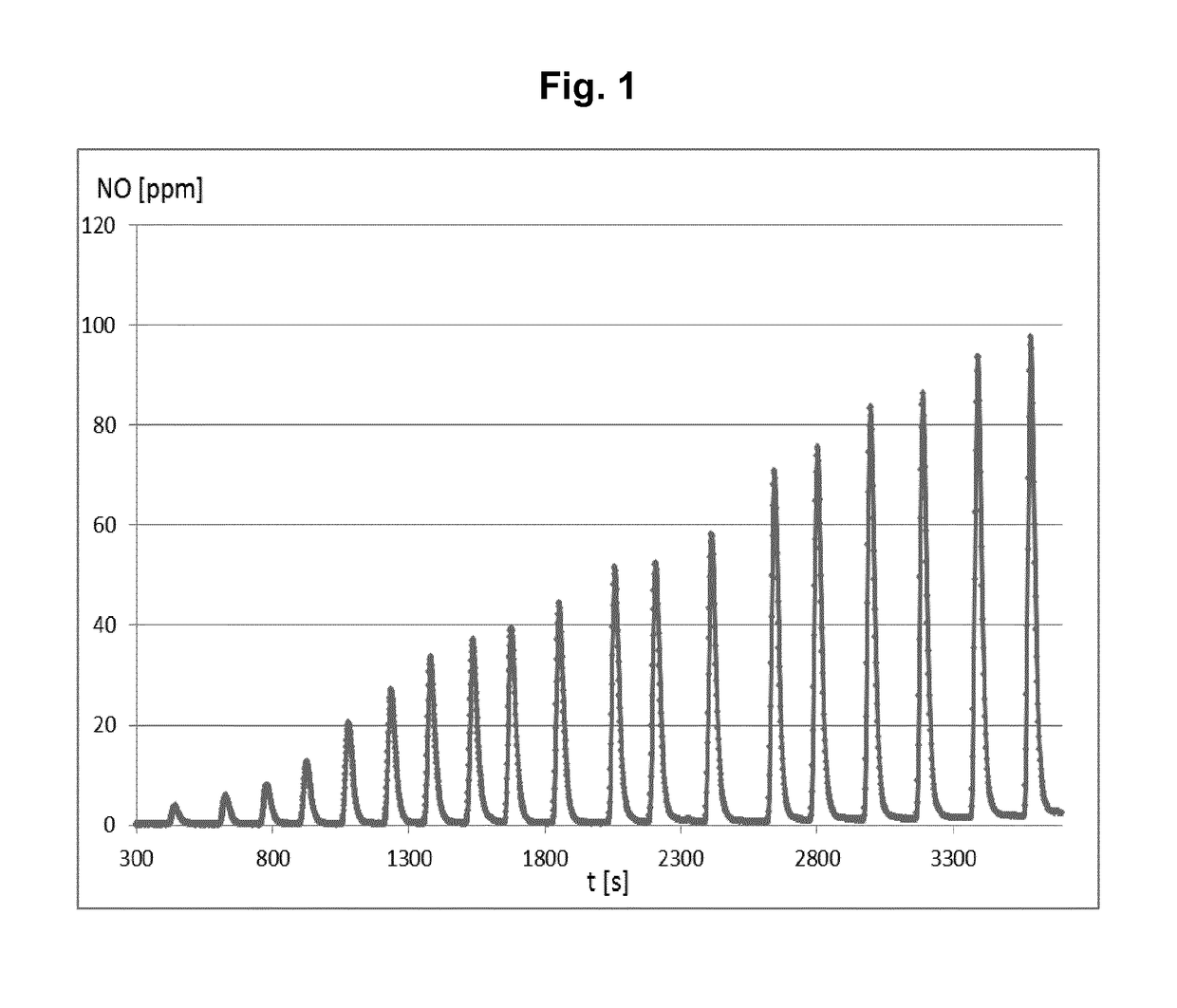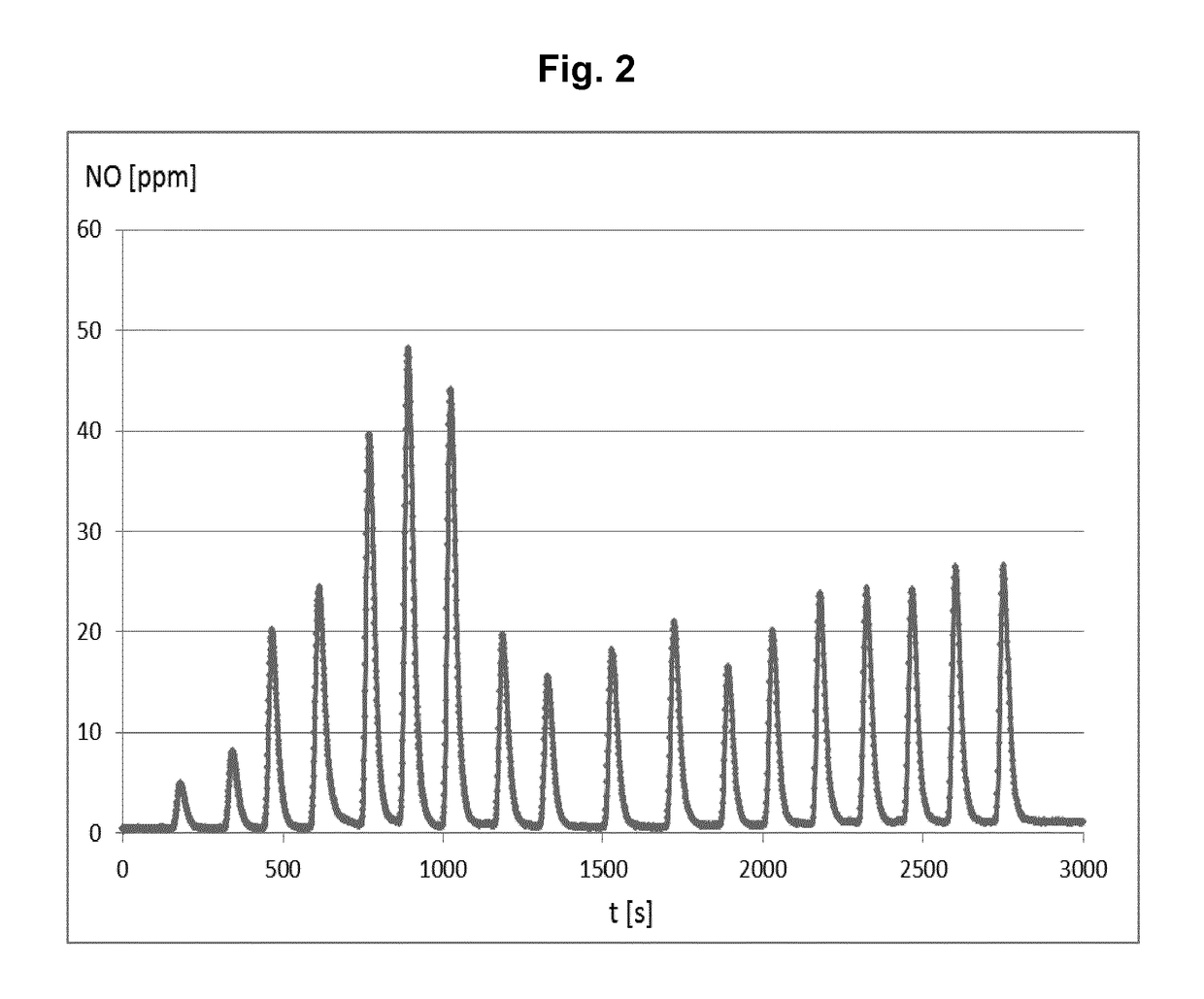Multi-step process for no production
a technology of no production and multi-step process, applied in the field of multi-step process, can solve the problems of insufficient control of release kinetics, no level of therapeutic relevance is established in this process, and it takes a significant period of time for release kinetics to be established, and achieves a high level of control over releas
- Summary
- Abstract
- Description
- Claims
- Application Information
AI Technical Summary
Benefits of technology
Problems solved by technology
Method used
Image
Examples
example 1
One-Step pH-Induced NO Production Process
[0216]1.1 Materials:[0217]Eco physics CLD 822: Quantification of NO[0218]Reaction chamber: Quartz glass, approx. 100×100×10 mm (approx. 100 ml volume)[0219]Buffer solution: 150 mM acetic acid, 150 mM NaOH in dist. water[0220]Base: 1M NaOH[0221]Sodium L-ascorbate[0222]1M NaNO2
[0223]1.2 Experimental Procedure
[0224]A total of 0.56 g sodium L-ascorbate were dissolved in 98.6 ml buffer solution, transferred into the reaction chamber, and 1.4 ml NaNO2 (1M) were added. Accordingly, the sodium nitrite concentration was 14 mM, the ascorbate concentration was 28.3 mM. The pH value of the final solution was measured to be 5.0.
[0225]For a period of 60 min, a 200 μl sample was taken in intervals of 2-3 minutes each and the NO content was quantified using the CLD system.
[0226]1.3 Results
[0227]The results of the NO measurements as a function of the reaction time are shown in FIG. 1. There is a continuous increase in the NO concentration, whereby a level cor...
example 2
Two-Step pH-Induced NO Production Process
[0228]The aim of this experiment was to reach a therapeutically relevant final concentration for an extended period of time through an active change of the pH value.
[0229]2.1 Materials:
[0230]The same material as in Example 1 was used.
[0231]2.2 Experimental Procedure
[0232]Initially, analogous to experiment 1, 0.56 g sodium L-ascorbate were dissolved in 98.6 ml buffer solution, transferred into the reaction chamber, and 1.4 ml NaNO2 (1M) were added. Accordingly, the sodium nitrite concentration was 14 mM, the ascorbate concentration was 28.3 mM. The pH value of the final solution was measured to be 5.0.
[0233]For a period of 45 min, a 200 μl sample was taken in intervals of 2-3 minutes each and the NO content was quantified using the CLD system.
[0234]2.3 Results
[0235]Initially, a continuous increase in the NO concentration was observed, whereby 1.5 ml NaOH (1M) were added in aliquots to the reaction chamber in the period of time between 10 and 1...
PUM
| Property | Measurement | Unit |
|---|---|---|
| pH | aaaaa | aaaaa |
| pH | aaaaa | aaaaa |
| molar ratio | aaaaa | aaaaa |
Abstract
Description
Claims
Application Information
 Login to View More
Login to View More - R&D
- Intellectual Property
- Life Sciences
- Materials
- Tech Scout
- Unparalleled Data Quality
- Higher Quality Content
- 60% Fewer Hallucinations
Browse by: Latest US Patents, China's latest patents, Technical Efficacy Thesaurus, Application Domain, Technology Topic, Popular Technical Reports.
© 2025 PatSnap. All rights reserved.Legal|Privacy policy|Modern Slavery Act Transparency Statement|Sitemap|About US| Contact US: help@patsnap.com



